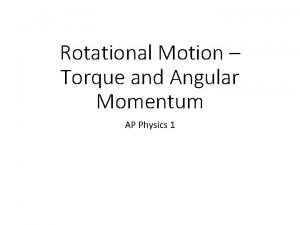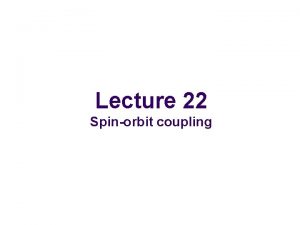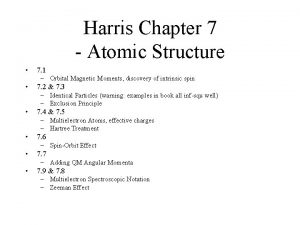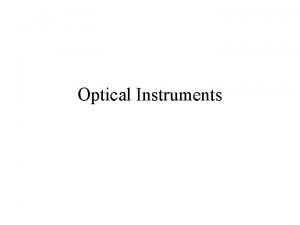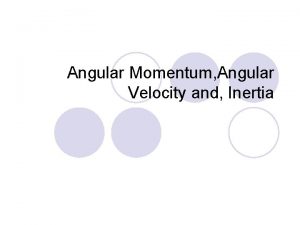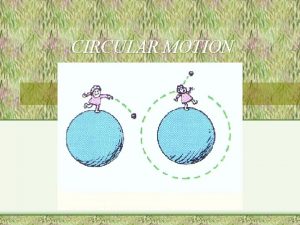Aim How do we explain angular speed angular












- Slides: 12

Aim: How do we explain angular speed angular acceleration?

Rotations Name things that rotate. Two different types of rotational situations: 1. Particle- moving in a circle 2. Rigid body or extended object-rotating about a fixed axis.

Rotational position Angles measured from a reference direction can be used to measure rotational or angular position.

Radians not degrees We use radians to measure angular position and not degrees. Θradians = (2π/360)θdegrees Angular displacement ∆θ=θf – θi (final angular position – initial angular position)

Angular distance vs. Translational distance We can relate the angular distance traveled to the translational distance traveled by using S = rθ

Angular Velocity and Angular Acceleration ω=∆θ/∆t Average angular speed = angular displacement/change in time α=∆ω/∆t Average angular acceleration = change in angular speed/change in time Can we write the corresponding equations for instantaneous angular velocity and instantaneous angular acceleration?

Using calculus-Problem 1 The angular position of a swinging door is described by θ = 5. 00 + 10 t + 2 t 2 rad. Determine the angular position, angular speed, and angular acceleration of the door. a) at t = 0 b) t = 3. 0 s ω(t) = 10+4 t AND α(t) = 4 a) θ(0)= 5 rad ω(0)= 10 rad/s α(0)=4 rad/s 2 b) θ(3)=53 rad ω(3)=22 rad/s α(3)=4 rad/s 2

Positive Signs and Negative Signs for angular velocity and acceleration If an object rotates counterclockwise, its angular velocity is positive. If an object rotates clockwise, its angular velocity is negative. Angular acceleration is positive when the change in angular velocity is positive and angular acceleration is negative when the change in angular velocity is negative.

Thought Question 1 Look at the graph of the angular position of the rotating disk below. Is the angular velocity of the disk positive, negative, or zero at (a) t =1 s, (b) t = 2 s, and (c) t = 3 s? (d) Is the angular acceleration positive or negative? a) Positive b) zero c) Negative d) Negative

Thought Question 2 Refer to the graph of the angular velocity of the disk. What are the (a) initial and (b) final directions of rotation? (c) Does the disk momentarily stop? (d) Is the angular acceleration positive or negative? (e) Is the angular velocity constant or varying? a) Clockwise b) counter clockwise c) yes d) Positive e) Varying

Rigid Body A rigid body is any system of particles in which the particles remain fixed in position with respect to one another. What is not a good example of a rigid body? JELLO

Thought Questions 3. A rigid body is rotating in a counterclockwise sense around a fixed axis. Each of the following pairs of quantities represents an angular position and a final angular position of the rigid body. Which of the sets can only occur if the rigid body rotates through more than 180 degrees? a)3 rad, 6 rad b) -1 rad, 1 rad c) 1 rad, 5 rad c) Is the answer (4 rad is greater than pi) 4. . Suppose the change in angular position for each of the pairs of values occurred in 1 s. Which choice shows the lowest average angular speed? b) Is the answer (2 rad/s is the lowest angular speed here)
 Theorem of angular momentum
Theorem of angular momentum Time speed formula
Time speed formula A narrow field of vision (140 degrees or less) is called...
A narrow field of vision (140 degrees or less) is called... Speed detection of moving vehicle using speed cameras ppt
Speed detection of moving vehicle using speed cameras ppt Explain orbital angular moment
Explain orbital angular moment Explain orbital angular moment
Explain orbital angular moment Red cat electrochemistry
Red cat electrochemistry Aim in biology
Aim in biology Aim isen
Aim isen Types of aim
Types of aim Apa itu previewing and predicting
Apa itu previewing and predicting Direct method of teaching english language
Direct method of teaching english language Ansp swim
Ansp swim
